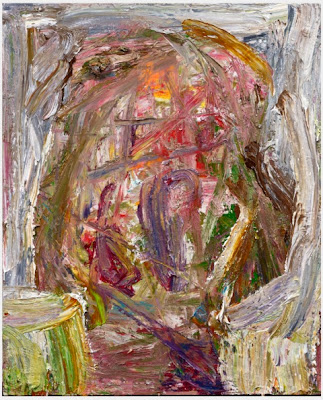Ian White Williams is an artist from Philadelphia. He came to my attention when I saw some posts on Facebook about his curated show PAIR: FORTY PAINTINGS, TWENTY PAINTERS at Proto Gallery. I love the concept and plan to see the show as it is up until February in Hobken, NJ.
Here is his statement on the show;
As a painter I am always excited about what happens in the studio when two paintings, conceived of and executed separately, find their way into proximate space. When paintings are paired their elements may alternately resonate and contrast, amplifying both the individuality and the continuity of the work. It is a process of exploration that often does not make its way outside of the studio. When I was invited to curate a show at Proto Gallery I decided that I wanted to present other painters with the opportunity to discover and show pairings of their own work in the context of an exhibition. I selected twenty painters whose work I admire greatly and asked them to choose a pair of paintings for this exhibition. The results are surprising, provocative and diverse.
I asked Ian to send me some images of his own work and write a few words about his influences which happen to be some of the artists in his show.
 |
|
Slight Drift
2013
Gouache on paper
7" x 5"
|
Statement:
Ian White Williams’s works are developed through an unfolding of responses. His process is one of action and reaction with the resulting meditations conveying the hum of the peripheral, the mundane and the under-considered, as he aims to capture the sensation of the intimate. The paintings are generated with a lightness and quickness of touch in a minimal process where the faintest influence or mark can tip the balance.
 |
|
Sharps
2013
Marker and gouache on paper
9" x 5.5"
Influences:
|
The question of influences is a good one, and one that I have had a bit of a complex about for quite some time. One of my clearest memories of applying to grad school was being interviewed by a panel of professors and current students at a certain program which will remain unnamed. Things were going well in the interview when someone asked which artists had the strongest influence on my work. I responded frankly, as I only could, and told them that I was most influenced by the work that I saw around me every day, the work of my fellow students at Tyler (where I was doing my undergrad), and even more so by the work of my closest friends. As soon as the words passed my lips I saw the blank disapproving stares of the panel, and knew then that I was not going to be offered the spot. At least that is how I remembered things going. My response may not have, in fact, sealed my fate, but it certainly didn't help. What is certain is that I have always felt insecure about the question of influence. As if I was constantly trying to be sure that I was liking the "right" artists, and that I was able to quickly and freely rattle off a list of artists that were both known, but not too well known. Edgy, but not the flavor of the month. I should never cite my best friend as artistic influence, but I also dare not admit to my love for Monet or the like. I offer this personal history of social anxiety simply to frame my response as I would present it now, older, no less anxious but strangely satisfied with the somewhat pedestrian reality of my limited art vocabulary and reference.
 |
|
Brachiate
2013
Marker and gouache on polypropylene
6" x 4.5"
|
So here it goes. My biggest influences are... my friends. But in all seriousness, I currently am fortunate enough to work out of two studios, each of which I share with another painter. I have a studio in Philadelphia that I share with Tim Schwartz (whom I have been close friends with for almost 20 year) and a studio in Ambler, PA that I share with David T Miller (whom I work with everyday as a high school art teacher). The conversations we have about process and content and the paintings I watch them create, clearly have the most direct impact on me as an artist. Far greater than anything I have seen in a gallery or read in a book. Tim also served as my primary conduit into the language of painting as I transformed my practice away from sculpture a few years ago (my undergrad and graduate degrees are both in sculpture). Beyond my closest friends, Facebook has completely changed this notion of influence for me as well. To be able to so easily view the work of and communicate with artists from all over the world is truly revolutionary. It would be impossible to list all of the Facebook artists that have impacted me and my work but here is a brief playlist: Inga Dalrymple, Inge Decuypere, Lauren Collings, Michael Voss.
 |
|
Lost From Looking
2013
Oil on Linen
12” x 17”
|
I do have influences in the traditional sense (i.e. artists beyond my reach either do to history, prestige, or otherwise). Among those Raoul DeKeyser probably leads the pack. But I also look at some Robert Motherwell, Helmut Federle, John Zurier, Edouard Vuillard, to name a few more.
 |
|
Break In the Family
2013
Ink & gouache on
polypropylene
6” x 5”
|
These are all words regarding the visual artists that influence my work. In truth, when I am actually painting these people and things could not be further from my mind. My actual influences vary from painting to painting and can include anything from a window latch, to a Circus Lupus song, to a shadow on my paper, to the void in my coffee cup.























